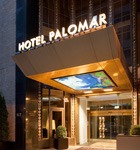HOTEL PALOMAR
architect
Gensler
interior designer
Powerstrip Studio
client
Kimpton Hotels & Restaurants
location
Philadelphia
size
156,000 square feet
completed
2009
website
hotelpalomar-philadelphia.com
Kimpton Hotels & Restaurants has been practicing sustainability for years, but it wasn’t until Hotel Palomar that the hospitality provider fully merged its corporate philosophy of environmental conservation and consciousness with one of its properties. The hotel owner and developer teamed up with architecture-and-planning giant Gensler to work on the adaptive reuse of a deteriorated Art Deco high-rise in Philadelphia, originally built in 1929. The resulting structure is in line with Kimpton Hotels’s typical luxury aesthetic, but it also earned LEED Gold certification thanks to a number of eco-friendly features. Hotel Palomar’s Nick Gregory and Gensler’s Matt Wolfe took gb&d inside the hotel’s design and operations.
site/
“The client sought out a historical building with the intent to reinvent and bring new life to the structure,” says Wolfe, sustainable strategist at Gensler. “The finished project was a high-end, 4-star boutique hotel.” Located in a lively section of the city, the dated building underwent renovation and refurbishment from Kimpton through an adaptive-reuse process, preserving the majority of the original structure. “Adaptive reuse is one of the more sustainable ways to approach a project,” Wolfe says. “We took the building that had incredible energy and leveraged its character to introduce a modern facility while adhering to our sustainable strategy.”

As seen in the floor plan, the adaptive reuse shrewdly uses the space it has.
plans/
Wolfe and interior designer Danya Lee, from Powerstrip Studio, were charged with designing a sustainable hotel that wouldn’t look or feel sustainable—one where hospitality norms wouldn’t be forgotten nor luxury compromised. The two blended sustainable products and design to create a modern, edgy hotel “One of the misconceptions of sustainable design is it has an inherent feel to it, and we definitely changed that view on this project,” Wolfe says. In 2006, at the time of the design, sustainable materials weren’t as readily available as they are today, so tremendous care went into material and system selection. Gensler and Powerstrip Studio used an energy model and plugged in all the energy-dependent systems to understand how the building would perform. “We were able to refine the design of the systems to ensure they’d have a positive impact on the building’s performance,” Wolfe says.
operations/
Nick Gregory, director of operations and general manager of Hotel Palomar, says hotel staff observe as many as 100 different green practices as part of their day-to-day operations. Practices such as recycling toner, using soy-based ink, including recycling bins in every guest room, and conducting on-screen checkouts are part of Kimpton Hotels’ Earth Care standards.

The historical building is in Philadelphia’s Rittenhouse Square neighborhood, a thriving retail, tourism, and business area. Photo: Peter Kubilus.

Exterior renovations included refitting its windows with insulated, low-E glass, and its canopy features illuminated artwork depicting Benjamin Franklin. Photo: Peter Kubilus.

The Hotel Palomar’s new staircase is clad with reclaimed walnut wood and connects the first-floor bar with a second-floor restaurant. Photo: Peter Kubilus.
exterior/
Having suffered years of neglect, the building’s exterior underwent extensive restoration. Portions of the brick façade were repaired or replaced, and the original windows were switched out for windows with insulated glass and a low-E coating. Also, the highly ornamented three-story building front, which was covered in the 1970s, was re-exposed.
interior/
The interior had little salvageable historical fabric. Elements within the library and second-floor elevator landing were restored, but in most cases the hotel needed to be remade afresh, and sustainable technology had to be included. Occupancy-sensing infrared thermostats help control temperatures by automatically adjusting when the room isn’t in use, and more than 90 percent of the hotel’s equipment—including appliances, ice machines, alarm clocks, and flat screen TVs—is Energy Star rated.
materials/
From the metal studs to the beer-bottle-glass bar top, more than 20 percent of the Hotel Palomar was built from reused materials. There is recycled-glass tile in every guest room, and the decorative stair that wraps around the restaurant was made from reclaimed walnut. A majority of the structure’s lumber is FSC-certified, and all its paints, sealants, and adhesives meet strict low-VOC standards. The project was even able to earn a last-minute LEED point for its cork ceiling tiles and other rapidly renewable materials within its restaurant.
water/
A highly efficient water-source heat pump serves the guest rooms and contributes to a 40 percent energy reduction, and the installation of low-flow fixtures allowed the hotel to achieve more than a 20 percent reduction in water use. “That was one of the more challenging efforts because at a hotel the shower is one of the most water-consuming fixtures,” Wolfe says. A shower fixture that dispensed two gallons per minute satisfied the sustainable requirements without compromising the guest experience or the aesthetics of the hotel.

